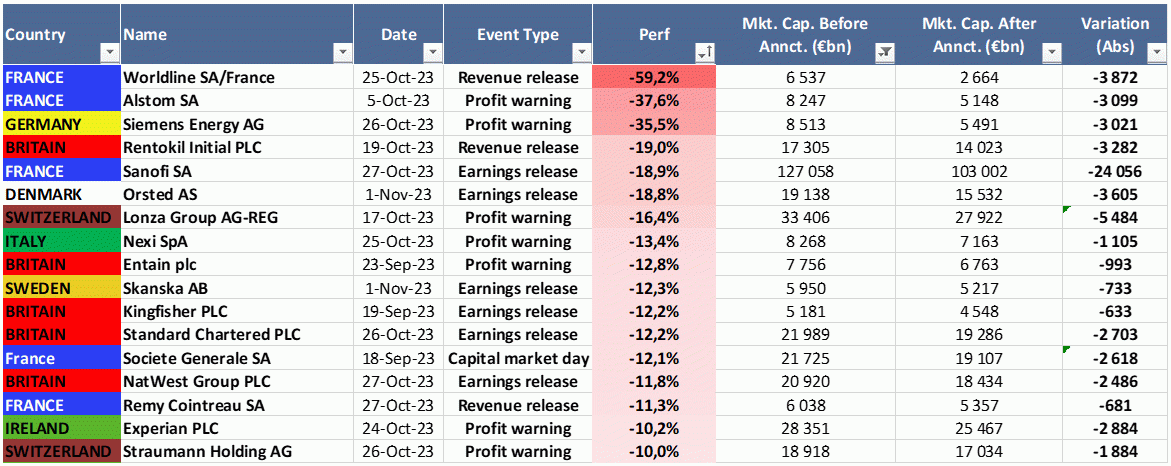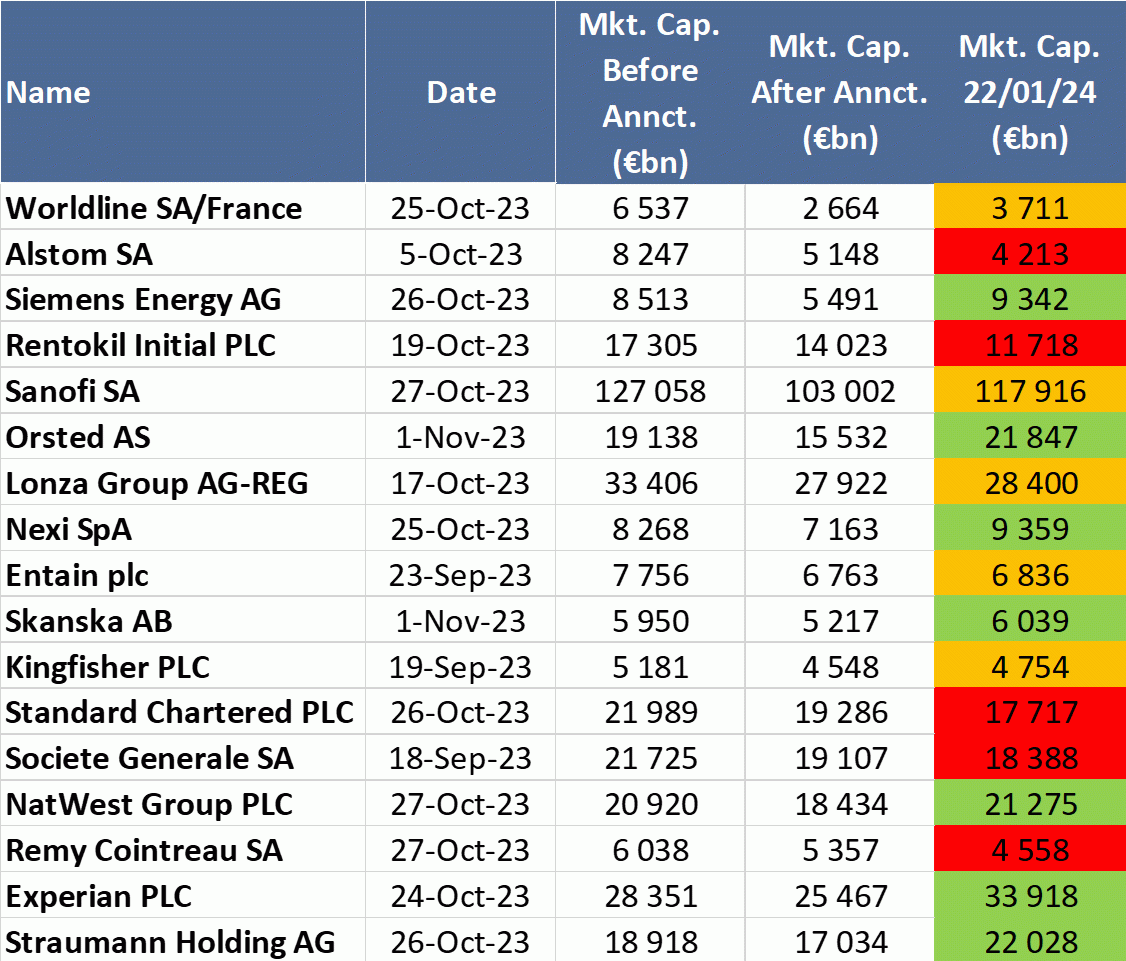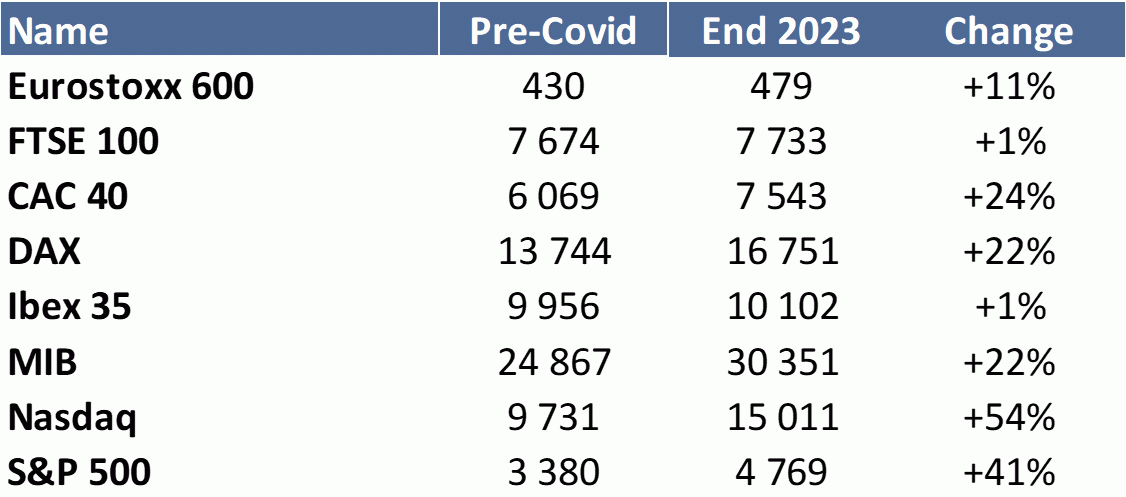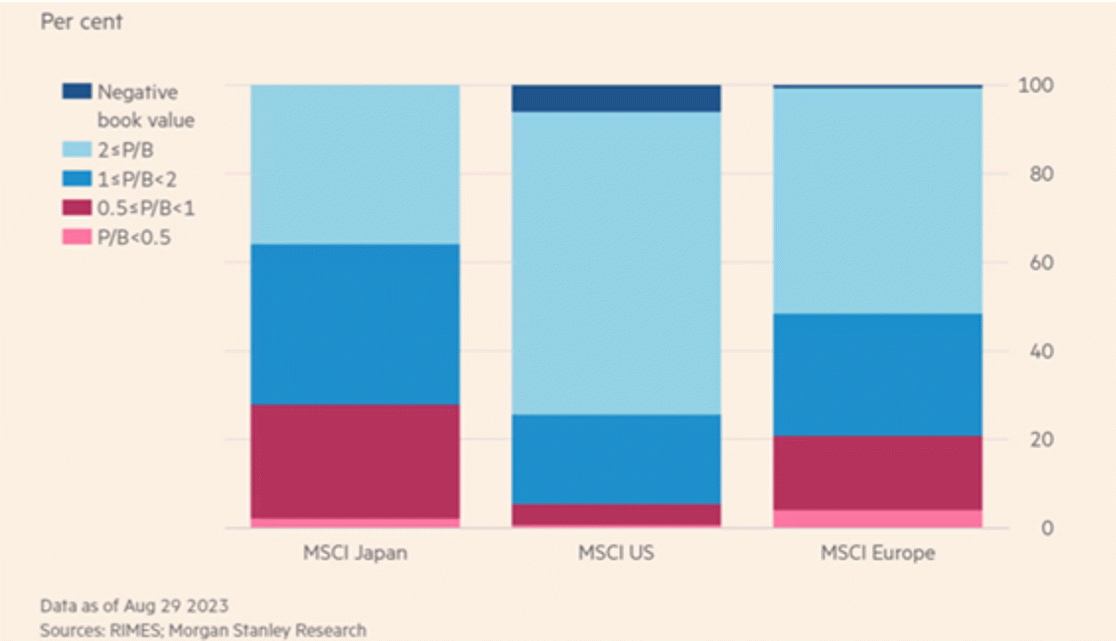Letter number 154 of January 2024
- TOPIC
- STATISTICS
- RESEARCH
- QUESTIONS & COMMENTS
- NEW
News : How can we explain the series of spectacular falls in the stock prices of certain groups?
Over the last few months, we have seen sharp prices falls of certain stocks over the course of a trading session - Worldline, Alstom, Siemens Energy, and so on.
These falls are not due to an overall fall in the market but to the market taking on news specific to these securities. This phenomenon is all the more striking in that it affects not only small groups whose stocks have low liquidity, but also some of the largest companies on the stock market. For example, Sanofi (the CAC 40's 6th largest market capitalisation) lost almost 19% of its market capitalisation on 27 October.
An analysis of the Eurostoxx 600 shows that the one-day falls have been much steeper over the last six months than previously:
All the major falls in the stock prices of large groups are linked to the publication by these companies of press releases on their results or by the press of rumours about the group's activity, and not to flash crashes[1].
It should be noted that such sharp reactions only occur downwards, and that the announcement of better-than-expected results does not trigger rises of such abnormal amplitude.
We find some of the explanations given by market professionals unconvincing:
- Sudden falls are accentuated by the environment of rising interest rates. We do not see why a downward revision of stock prices following an announcement of poorer than expected results would automatically be much greater in a higher interest rate environment, especially as, while risk-free rates have risen sharply, the impact on the rate of return required by shareholders has been much lower, given the corresponding fall in the market risk premium.
- There are fewer institutional shareholders in Europe than in the United States, and valuations are therefore more arbitrary (markets less efficient) on our side of the Atlantic. This basic assumption is simply wrong: individuals with little knowledge of finance are much more active in the United States, which generates meme stocks [2] phenomena that are significantly more widespread than in Europe (AMC, Bed and Beyond...). And anyway, sharp falls in stock prices have recently been uniform on both sides of the Atlantic!
The justifications for falls are above all fundamental, i.e. the new information transmitted to the market seems likely to justify a substantial fall in the stock price. This was the case for Worldline, whose price fell by 59% on 25 October following the announcement of its quarterly sales figures. The fall is indeed unprecedented and impressive, but at the time of publication, Worldline had revised its estimate of annual free cash flow downwards by 38%, and by 63% for the second half of the year... This has a significant impact on all valuation models.
It is also very likely that, in addition to the revision of free cash flows, the market will make an upward correction to the required rate of return on Worldline shares, via a higher beta coefficient. Worldline's market risk appears to be much greater than expected, given the sensitivity of its results to the economic situation (slowdown in Germany), which is much greater than anticipated, and management's inability to forecast results, except at the last minute.
Other examples, although less impressive, make just as much economic sense. The falls in the stock prices of Siemens Energy (-38% on 26 October) and Alstom (-35% on 5 October) are linked to the announcement of worrying news: the need for €10bn in guarantees to support growth in the case of Siemens, and very negative cash flows for the year in the case of Alstom. It should be noted that these two companies operate in sectors with long contracts, where profitability is very difficult for an external analyst to assess. Fluctuations in working capital requirements are also very significant. Alstom's negative cash flow in the first half of 2023 represented 14% of its market capitalisation. Enough to scare shareholders...
It is generally difficult to measure whether the degree of the fall correctly reflects the bad news announced. Nevertheless, a large proportion of stock price falls persist over time, proving that this is not a one-off overreaction, but rather a fundamental review of value by shareholders.
One technical argument seems plausible to us: a scarcity of fundamental investors to drive stock prices. Strong growth in passive management (or index-linked management) is perfectly consistent with efficient portfolio theory, but implies that fewer and fewer investors are actually choosing the stocks in which they invest on the basis of their undervaluation and growth potential. In a market with fewer fundamental investors, a falling stock price will not be slowed as much by investors who may see a good bargain to be had, since there are fewer of them to be able to reason in this way.
The fall in the price of Rentokil's stock certainly illustrates this point. It fell by 19% on 19 October on the announcement of a marginal revision of targets. Analysts following the stock were surprised by such a sharp fall. But it has to be said that investors have not resumed buying on a massive scale, and the price has remained low.
It is likely that the market is currently valuing companies on the basis of particularly positive scenarios. Although the profits of most listed companies have risen sharply, some might find it surprising to see that most European stock market indices (excluding the UK[3]) are more than 20% above their pre-covid levels, and the US markets more than 35% above, when on the one hand interest rates are significantly higher, leading to an economic slowdown, and on the other hand the geopolitical situation has deteriorated sharply (war in Ukraine, Israeli-Palestinian conflict). As a result, the slightest piece of bad news has a significant impact on stock prices, whereas good news has already been factored into the valuation. When investors put on their rose-coloured spectacles, they remain very optimistic, until reality catches up with them.
[1] A sudden, brief fall in the price of an asset due to a one-off error or IT failure, which is usually quickly corrected by an equally sudden rise (which may compensate in full or in part).
[2] Stocks that are very popular with small, inexperienced investors, often with no economic or financial justification, and whose popularity is fuelled by social networks.
[3][3] The FTSE 100 is only very slightly up . The Eurostoxx 600 index is up by a moderate 11%, as it includes groups from continental Europe as well as 141 British groups.
Statistics : PBR of leading listed companies
Published by the Financial Times, this graph of the Price Book Ratio (PBR), or the ratio of the value of shareholders' equity to the amount of equity capital contributed by shareholders or left at the company's disposal in the form of earnings not paid out as dividends, to some extent caricatures the Japanese, European and American stock markets:
In Japan, of the 236 companies that make up the MSCI Japan index - in other words, the largest and best-performing companies, the smallest of which has a capitalization of $1.4 billion - only around 70% have an equity value greater than the funds entrusted to them by their shareholders. No wonder the Tokyo Stock Exchange recently slammed its fist on the table, requiring those with PBRs below 1 to adopt plans to remedy this value destruction, failing which their names will not appear in the list of value-creating companies.
In Europe, the proportion of PBRs below 1 is lower among the 428 companies that make up the MSCI Europe index (the smallest capitalizing $2 billion), at around 20%, but the proportion of listed companies with a PBR below 0.5 is double that of Japan, at around 5%, including Société Générale, ArcelorMittal and Renault, for example.
In the United States, what's surprising is the share of listed companies with negative PBR, 5%, whereas they are virtually non-existent in the other two geographic zones. These are the so-called meme stocks, such as AMC. On the other hand, 90% of listed groups have a PBR greater than 1.
Research : Highlighting a pollution premium in asset valuation
With Simon Gueguen, lecturer-researcher at CY Cergy Paris University
The asset valuation models used to explain past performance and predict future performance of financial assets include various risk factors. Each additional risk leads to a higher required return (which is obtained in equilibrium), or to put it another way, a lower price. The systematic (non-diversifiable) risk found in the CAPM beta forms the basis of these models; research has made it possible to gradually add other risk factors, linked to the size of the company, its governance or its exposure to particular macro-economic risks. Taking these risks into account improves the accuracy of the model. Each of these is associated with a risk premium, i.e. an additional return required on the securities (in this case, equities) concerned.
This month we present a landmark article[1] . It highlights the existence of a pollution premium: the shares of the most polluting companies are more profitable than those of non-polluting companies, and this higher profitability is justified by the fact that polluting entails risks that are not taken into account in other factors. The result in itself is not really surprising, but the article has the merit of measuring it over a large sample and over the long term, and of proposing an improvement to the usual models by incorporating this premium.
The central result of the article is the measurement of the extra profitability obtained by investing in the shares of polluting companies. Hsu et al base their study on a sample of US companies between 1991 and 2016. They use data supplied by the US Environmental Protection Agency (EPA), in this case levels of chemical pollutant emissions measured plant by plant. They then divide the titles in the sample by pollutant emission quintiles, relative to the sector. The first quintile is made up of the 20% of shares in companies with the lowest level of pollution relative to their sector of activity. They then construct a high versus low long-short portfolio, i.e. they buy the most polluting stocks (in quintiles) and sell the least polluting. The performance obtained is positive and very significant, at 4.42% per annum. In other words, while the least polluting stocks outperform the risk-free rate by 6.90%, the most polluting outperform it by 11.32%. None of the risk factors usually considered in the literature can explain this result. For example, it has been established that small caps outperform large caps, but taking this into account does not change the results for pollution.
Hsu et al therefore propose incorporating pollution levels as an additional risk factor in asset valuation models. The fact that the stocks of polluting companies achieve a significantly higher return than others over the long term means that, for the market, these stocks are riskier, without this risk being taken into account by the other factors. In the proposed model, a regulatory state decides from time to time, when environmental costs are high, to tighten up legislation on pollutant emissions. Whenever this happens, it has a negative impact on companies that are above the threshold and incur a high cost of adjustment. The possibility of these shocks is taken into account by the market, which results in a lower price for the securities concerned, or, what amounts to the same thing, a higher required return. Over the long term, the return on these securities is higher, but at the cost of shocks to value each time legislation is tightened.
To support this model, the authors measure the market reaction at the time of when Donald Trump was elected in 2016. The most polluting stocks rose by 6.31%, compared with 3.64% for the least polluting. The idea was that Trump's stance could provide 'reassurance' that anti-pollution legislation would not be tightened, thereby increasing the value of companies potentially affected by such tightening.
Finally, it should be noted that this article focuses exclusively on asset valuation and not on ESG issues as such. It highlights the existence of a pollution premium, formalising it and justifying it from the investor's point of view. The article does not discuss the implicit consequences for financing, but it is worth pointing them out: if pollution results in a premium for the investor, this means that it increases the cost of capital for the company. This may justify a clean-up effort at company level, even if motivated by strictly financial considerations.
[1] P. H. Hsu, K. Li and C. Y. Tsou (2023), "The pollution premium", Journal of Finance, vol. 78(3), pages 1343 to 1392.
Q&A : How do you deal with frozen term deposits in financial analysis and valuation?
"A bank requires the borrower to set up an escrow deposit in order to grant a larger long-term loan. How should this be treated in financial analysis and valuation?"
In financial analysis, this frozen term deposit, which is the counterpart to a long-term loan, cannot be considered as cash, since it cannot be converted into liquid assets without repaying all or part of the long-term loan. It is therefore not included in the liquidity ratios. When calculating net bank and financial debt, it is deducted from gross debt.
In valuation, its illiquidity should not lead to it being considered as a non-value, and it should be included for its amount, capitalized interest where applicable, in the bridge from the enterprise value to the value of shareholders' equity.
New : Comments posted on Facebook
Regularly on the Vernimmen.com Facebook page[1] we publish comments on financial news that we deem to be of interest, publish a question and its answer or quote of financial interest. Here are some of our recent comments.
15th anniversary of Adolf Merckle's death
Except to some of our German-speaking readers, this name won't say much. It was that of a 74-year-old German industrialist (HeidelbergCement, Ratiopharm, Phœnix Pharmahandel, etc.) who had become his country's 5th richest man and who, in the early hours of 5 January 2009, left his family home in Blaubeuren to lie down on a nearby railway track.
How could anyone go to such extremes?
By short-selling Volkswagen shares that economic and financial analysis showed to be grossly overvalued, but ignoring the fact that a secret battle going on within the founding family was leading some of its members to buy Volkswagen shares whatever the price, causing it to jump from €211 to more than €900 in two days. ...
While there were many theoretical opportunities for short-selling in 2023 (Orpéa, Casino, Atos, etc.), this sad example should serve as a reminder that short-selling is a particularly risky investment technique, with the potential to lose far more than the amount invested. There is a reason why short-selling specialists rarely use it over long periods, even if they are convinced that a stock is overvalued. In this regard, we are reminded of the aphorism of the economist J.M. Keynes, whose fortune owed at least as much to the fruits of his skillful speculation as to his royalties and courses: "Markets can stay irrational longer than you can stay solvent. »
British American Tobacco is writing down the value of its brands
Impairment of goodwill does not usually have a significant impact on share prices, because goodwill is simply written down to reflect a loss of profitability that has already been taken into account by the market, since accounting naturally lags behind economic and financial reality.
When BAT announced that it was writing down £25bn of its cigarette brands (Pall Mall, Newport, Camel, etc.) on 6 December, for 31% of their book value, its stock market value fell by 8% in one session, a fall that has not since been offset, even partially, which is why we waited to tell you about it. The reason is that this announcement was accompanied by the decision to write off these brands over 30 years, on the assumption that, given the changing consumer habits of its customers, these brands would no longer have any value in 30 years' time and that this business, in this form, would have disappeared. This loss of value in 30 years' time had not been anticipated by investors, who consequently reduced their free cash flow expectations, causing BAT's share price to fall. In fact, the new tobacco consumption brands are new to BAT (Vuse, Velo, Glo) and not the historical brands.
Coincidentally or not, the £25bn write-down reduced the amount of book equity to more or less the same level as market capitalisation, leading the CEO to say that this was a case of accounting catching up with reality, overestimating investors' ability to grasp reality as accurately as possible. This suggests that there may be further downturns of this type in sectors where significant changes may be difficult to quantify correctly, and we are naturally thinking of the effects of the energy transition.





